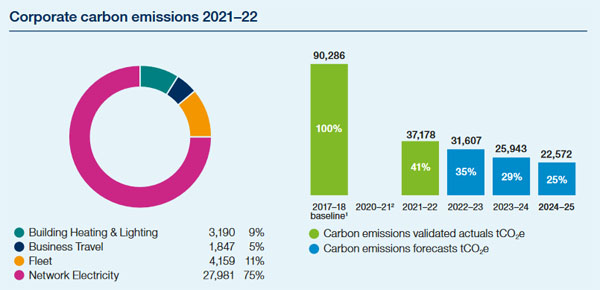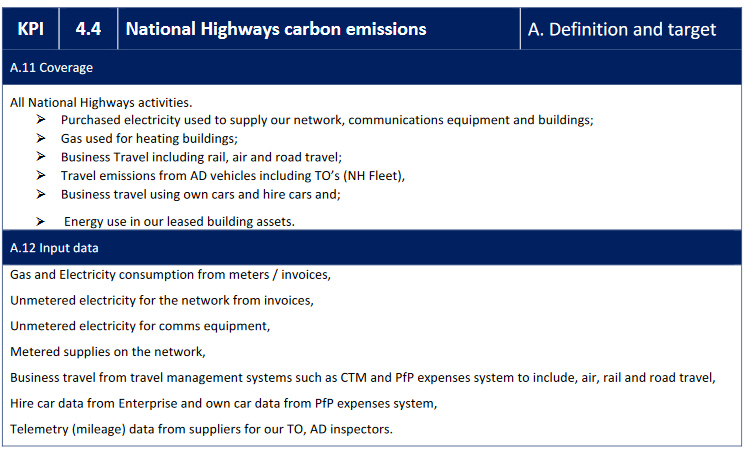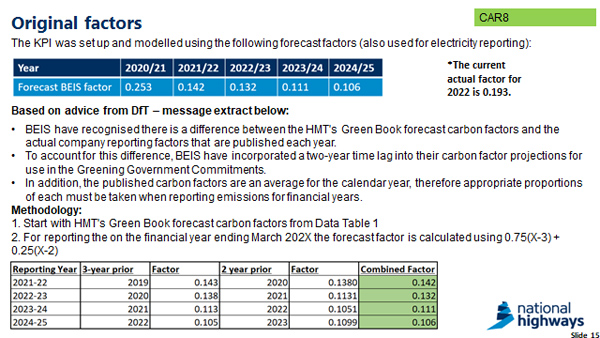National Highways significantly under-reported its operational carbon emissions for the last financial year by using an out-of-date forecast of emissions from grid electricity, rather than ‘actual’ data, Highways can reveal.
The government-owned company has a key performance indicator (KPI) to cut operational emissions by 75% against a 2017-18 baseline by 2025.
For 2021-22, the company reported 37,178 tonnes of carbon dioxide equivalent (CO2e), a cut of 59% against the baseline, with around 90% of emissions coming from grid electricity.
It cited the same figure in its 2022 annual report and accounts. In the annual report, a graphic presented the 2021-22 figure as 'actual' data. This was not true: the figure was produced using a forecast of carbon emissions from electricity.

If it had calculated its electricity emissions for the year according to normal company reporting methods, as it had done previously, they would have been around a third higher. Companies usually multiply their electricity by an 'actual' carbon factor based on the UK Government GHG Conversion Factors for Company Reporting.
Backroom deal
But National Highways claims that a behind-the-scenes deal with the Government allows it to use adjusted 2019 forecasts for the carbon emissions from grid electricity when reporting against the KPI, even when the emissions forecasts turn out to be inaccurate, giving it a one-way bet.
In a document seen by Highways, it claimed that ‘during metric development it was agreed that National Highways would use BEIS forecasted carbon factors rather than actual carbon factors seen in year for electricity’.
The document adds: ‘It was agreed that we would use the GGC [Greening Government Commitments] target, whilst not being accountable should the grid not decarbonize as BEIS predict.’
The difference between the forecasts and the ‘actual’ figure is significant. In 2021-22, National Highways used a forecast carbon factor of 0.142 to calculate its emissions from electricity. As it noted in a document sent to its monitor the Office of Rail and Road (ORR), ‘the current actual factor for 2022 is 0.193’.
Reporting trouble
Despite this huge difference, neither National Highways nor the ORR had been able to a provide definitive account of the methodology that should be used and both have given Highways inconsistent and contradictory explanations on this issue.
Asked which document set out the methodology, the Department for Transport (DfT) cited National Highways’ Operational Metrics Manual.
This document states that it 'is primarily used by National Highways, the ORR and the Department for Transport to ensure all performance measure definitions and targets are clearly understood'.
The document is also publicly available 'so that road users and our other stakeholders can clearly see the basis on which we are being monitored across all the outcome areas'.

However, the document does not state what carbon factor should be used for the operational carbon KPI, leaving the public in the dark and the ORR dependent on National Highways’ assertions.
While the ORR has asserted that any changes to reporting are subject to formal governance procedures, documents seen by Highways support a claim from the government-owned company that it ‘evolves’ the methodology and that the ORR acquiesces in the change.
For example, the document in which National Highways claimed that it was entitled to use carbon forecasts is version 17 of an internal performance plan, which was supplied to the ORR only last Autumn.
The ORR told Highways that this document states the ‘correct carbon factors’.
Prior to this, the ORR had, in turn, said that the KPI reporting was ‘aligned with the appropriate UK Government GHG Conversion Factors for Company Reporting’; that ‘electricity emission factors were set at the start of RIS2, using forecast emission factors from [BEIS]; and that ‘when reporting the actual emissions in-year, such as 2021/22 emissions, the gross GHG conversion factor is used’.
This last statement goes to the heart of the issue: National Highways does not report actual emissions.
Performance not carbon related
In addition, when National Highways reported operational emissions for 2021-22 that were higher than the stated trajectory to meet its KPI target, it assured the ORR that they were nevertheless within 'range'.
This range however was the range used for performance related pay targets and had nothing to do with carbon reporting accuracy.
Despite this, the ORR then publicly stated that the company was ‘on track’ to meet the KPI target.
Complex targets
Since the confusion arose over which methodology National Highways should have used, the ORR has refused to state whether the 2021-22 reporting was correct.
While it appears reluctant to dispute National Highways' assertion that it is entitled to use a forecast, the ORR has indicated that it regards the process as unsatisfactory.
A spokeperson told Highways: 'The use of emission factors adds to the complexity of this target. This is why we have also asked National Highways to report its actual electricity usage to us as part of our monitoring of this KPI.
'This will enable us to hold the company to account for how it is delivering its plans to reduce electricity use, which are unaffected by carbon emission factors.'
National Highways has acknowledged that it previously used an actual carbon factor before switching to the forecast model. But it has insisted that it correctly calculated its carbon emissions for the year using the forecast carbon factor, which it says is the appropriate methodology for the KPI.
However, it still occasionally slips back into misreporting its current situation.
Last month for instance, using words almost identical to the ORR’s initial explanation, it stated: ‘The data provided to the ORR was for the Corporate Carbon KPI reporting which is aligned with the appropriate UK Government GHG Conversion Factors for Company Reporting where the UK Electricity grid average CO2e emissions per unit of electricity consumed is used to calculate emissions.’
It added that this methodology is ‘based on Greening Government Commitments’ (GGC).
Last week it told Highways: ‘The 21/22 figures relate to our KPI and are based on c.172,000 MWh calculated using the forecast factor of 0.142 when the target was set.’
It added: ‘Our annual report showed our Carbon KPI which is separate to our reporting under the Greening Government Commitment.’
The Operational Metrics Manual contradicts this claim. It states: ‘In order to support Government to achieve the GGC and Net Zero ambition, NH has agreed an ambitious target of a 75% reduction in corporate carbon emissions from a 17/18 baseline by 2025.’
In its annual report, the company stated: ‘The UK’s grid decarbonisation has made a significant contribution to our emission reductions.’
This was misleading. The emissions reductions stated resulted not from actual decarbonisation of the grid but inaccurate government predictions.
In its annual report, the company also stated: ‘Achieving our 75% reduction will be contingent on the realisation of government’s predictions for the carbon intensity of the grid by 2024–25.’
This was also untrue. According to the company’s own explanation of the methodology, the KPI is to be reported using the Government’s predictions for the carbon intensity of the grid, irrespective of what actually happens.
According to a document sent by National Highways to the ORR, with forecast grid decarbonisation doing most of ‘the heavy lifting’, the company only has to achieve a 22% cut in its electricity to meet the 2025 target.
Out of date forecasts
Even if National Highways is entitled to use forecast carbon emissions, in the absence of a definitive methodology for the carbon factor, it is unclear whether it should have updated those forecasts.

National Highways sent the ORR this slide to tell it how its emissions should be calculated
The ORR told Highways that in June 2021, BEIS updated its emission factor forecasts and agreed with the DfT to adjust the March 2019 forecasts to better align the KPI and Greening Government Commitments with the new forecasts.
It stated: ‘The adjusted forecasts are the emission factors used for the Carbon KPI.’
However, National Highways has insisted that it ‘correctly’ had ‘not overridden the factor agreed as part of the KPI reporting methodology’.
In response to a request under the Environmental Information Regulations, the ORR provided Highways with a series of slides produced by National Highways in January 2023.
One slide of this document shows that, following advice from the DfT, National Highways obtained the carbon factor of 0.142 for 2021-22 by combining emissions forecasts from 2019 and 2020, reflecting concerns that the forecasts were not reflected in real-world emissions. This still left it at around three-quarters of the ‘actual’ factor, which was 0.193.
The ORR also provided its own spreadsheet analysis of National Highways’ calculations. This shows that, had the two-year time lag been applied to the updated forecast, a carbon factor of 0.1995 would have resulted, more than a third higher than the one used and very similar to the actual factor.
As Highways has reported, National Highways has said its electricity comes from a '100% renewable tariff. It is not permitted to discount emissions from electricity for the purpose of corporate reporting or its KPI and the ORR previously obtained an assurance that it was not doing this.





